January 24, 2014
Vol.16 Japanese Leather - Full of Surprises!
By Alice Gordenker

Recently a friend from Los Angeles visited me here in Japan. I helped her explore Tokyo and we made an overnight trip to Kyoto just when the fall colors were at their peak. The day before she returned to the U.S. she gave me a gift to thank me.
The gift was a small coin purse made of black leather. I held it in my hand. The leather was very smooth and soft to the touch, so I could tell it was of good quality, but there was nothing special about the purse itself. It had no pattern or texture. The design was very plain. To be honest, I felt a little disappointed at how uninteresting it was.
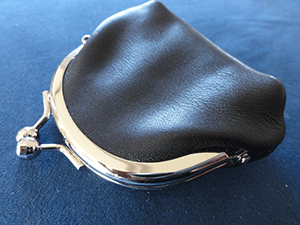
Then I opened the purse and got a big surprise. On the inside, the coin purse was bright and colorful, in total contrast to the outside. The cloth inside the purse was of a bright, busy pattern in vivid colors like magenta, yellow and blue.
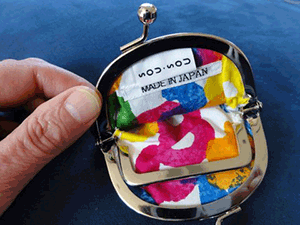
My friend laughed. "I choose this coin purse because it's just like you - quiet on the outside but wild on the inside!" A big smile broke out on my face because what she said was so clever - and true! The purse was made by Sou Sou, a trendy Kyoto fashion company internationally known for its tabi shoes in bright and unusual fabrics.
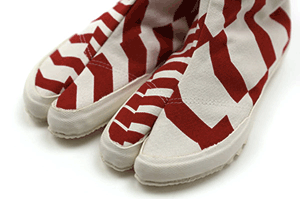
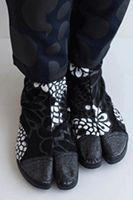
In the end, I felt very pleased with the gift because it was both clever and thoughtfully chosen. Aren't those the gifts that we remember best?
As my friend was packing, we talked about her visit and her impressions of Japan. "What I like best about Japan is how surprising it is," she said. "Everywhere I went I saw something new and interesting. For me, Japan is exciting and full of new discoveries."
I remembered those words when I sat down to write this essay. Most first-time visitors to Japan don't expect to find attractive leather products. They definitely don't come looking for leather, as they might if they were visiting Italy or Brazil. Japan is famous for many things, including beauty and function and quality, but it's not famous for leather.
Still, if foreign visitors happen to encounter leather products in Japan, they will be drawn to them if the products meet their expectations. People expect something "Made in Japan," to be beautiful, functional and of high quality. But to make foreign visitors not just admire but also buy Japanese leather goods, I think one more thing is necessary - the products should be surprising.
What, exactly, do I mean by "surprising?" Actually, my little coin purse is a perfect example. It is surprising because of the unexpectedly colorful pattern on the inside. A product can surprise by being unique, playful or delightful.
Here are some examples of Japanese leather products that I find surprising:
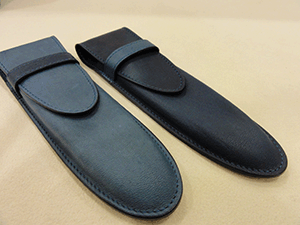
These beautiful pen cases are made in Tokushima Prefecture from leather dyed with the traditional "Aizome" dying technique normally used only for cloth. You probably can't find leather in these colors anywhere else in the world, which is why the company rightfully calls this product line, which also includes wallets and key holders, as its "Japan Blue Leather" series. (Kinuya.)

This elegant little party bag seems to be covered with jewels so you'd expect it to be quite heavy. But it's actually surprisingly light. That's because the leather is made by applying a special film to pigskin, for a look that is both substantial and classy. The metal work is done by skilled Japanese craftsmen, and the chain can be concealed inside to convert the bag from a handbag to a clutch. It's a perfect combination of traditional craftsmanship, new technology, function and beauty. (Hirata Fukuromono Kogei.)
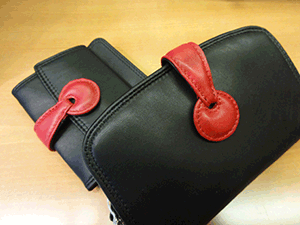
When I visited the Tanizawa showroom in Ginza, my eye was immediately drawn to these black wallets with their dramatic red trim. They are made of incredibly soft lambskin that just begs to be touched, but it is also the richness of the colors, as well as the color contrast, that makes them so delightful. (Tanizawa Ginza.)
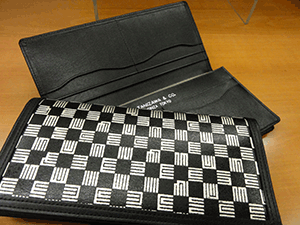
Another unique find in the Tanizawa store was this wallet made using traditional lacquer-on-leather techniques. Craftsmen in Kyoto apply lacquer to leather and, while the lacquer is still wet, apply thin strips of silver on top. The effect is very elegant and very Japanese. There are various products and colors in this series, which is called "Genji-ko." (Tanizawa Ginza.)

Finally, I love these "Sabi" handbags made from hand-dyed leather. "Sabi" means "rust," but in aesthetic terms, it also means a desirable imperfection (often expressed with the term "wabi-sabi.") As part of the dying process, craftsmen set metal objects on treated leather and let the chemical reaction create one-of-a-kind patterns of color and shading. (Princess Bag)
Japanese leather goods can compete in the world market by offering something different. Beauty, function and quality are musts - but companies will do best when they also offer something that can delight and surprise.

Alice Gordenker is an American who has lived in Japan for more than 15 years. A long-term columnist for The Japan Times, she writes regularly about Japan in English. She is quiet on the outside but wild on the inside.

October 24, 2013
Vol.15 Leather goods of South Africa have taken root in my life
Alida Kotzé
Hallo! My name is Alida Kotzé, and I'm from Cape Town in South Africa.I work as an English teacher at an eikaiwa and at a university. Why did I come to Japan? Many years ago I met a Japanese man in South Africa, fell in love ... and here I am.
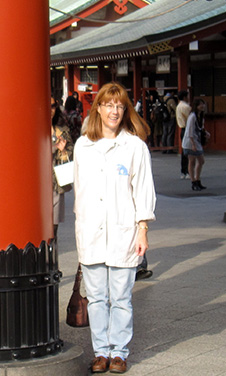
South Africans have an outdoors lifestyle and prefer natural fabrics rather than synthetic ones. We wear cotton clothes and flat sandals; don't use air conditioning; love wood, stone and natural light in our homes.
Leather is a part of our lives, not only as clothes, but also as furniture.
I remember my grandmother's "riempiesbank", a wooden bench with a seat made from a network of leather thongs. It looks just like a tennis racket, and it's surprisingly comfortable.
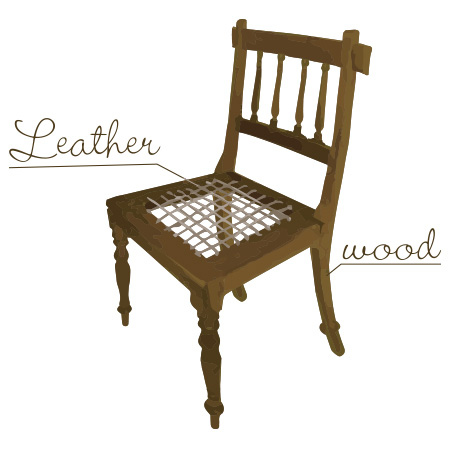
Nowadays a bench or chair made with "riempies" is regarded as an antique. It can be extremely expensive, especially if it's made from indigenous wood like yellowwood.
Modern leather couches are also very popular, but if you want to be a real South African, you must have an authentic riempiesbank.
Another item that is quintessentially South African is "velskoene" or "vellies", in other words, bush shoes made from leather. They have soft rawhide uppers that are attached to a leather footbed and a rubber sole. No nails or tacks are used; only glue and strong threads.
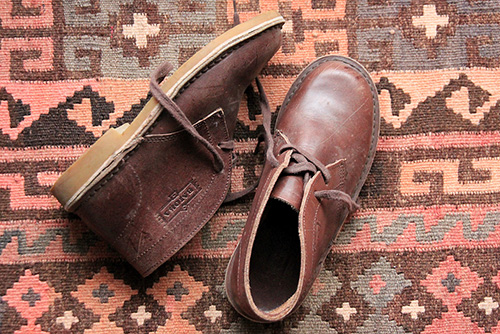
They're very light and very tough, and are ideal for walking on South African's harsh terrain. When I moved to Japan, I brought my favourite pair of vellies with me. I've worn them while walking in Tokyo, hiking in Yamanashi, fishing in Gunma and struggling through heavy snow in Niigata.
So far I've talked about products made from cow leather, but South Africa is also famous for ostrich leather with its characteristic pattern of bumps. It's very expensive, because it requires a complex production process by an expert. I have an ostrich leather wallet that I've been using for many years, and it still looks brand-new.
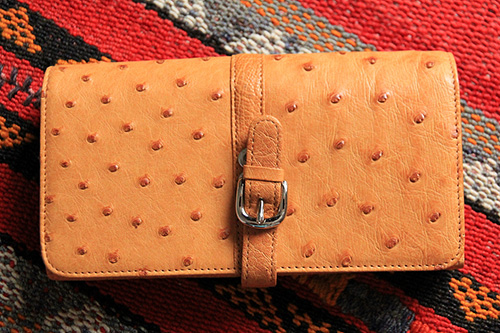
Here in Japan, leather seems to be mostly a fashion item, and products are made of a softer leather with finer details. There are so many excellent leather artists, but I'd like to highlight these three:
1) I love the products of a company called Tsuchiya Kaban. Their products appeal to me because it's so simple yet beautiful, subtle yet elegant. Their emphasis is on the quality of the leather and the craftsmanship, with no unnecessary decorations or fussy elements.
http://www.tsuchiya-kaban.jp/
2) A surprising discovery in Japan has been products made of horse leather, which I've never seen in South Africa. My personal favourite is Flying Horse.
http://flyinghorse.jp/
3) Finally, my dream is to have leather walking shoes made by Patrick Labo Ginza: they're strong, stylish and very comfortable.
http://www.patrick.jp/
What I really love about Japan's leather products is their excellent craftsmanship, which is much more refined than the rough-and-tumble approach of South Africa's leather products. Japan is world-famous for its attention to detail, and it's very clear that this extends to leather products: top-quality leather, top-quality finishing and ... best of all ... top-quality service when you enter any shop.

Cecilia Macaulay
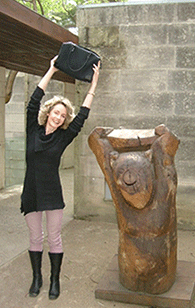
Hello, I'm Cecilia, from Melbourne, and I'm a Permaculture designer.
Every year hundreds, maybe thousands of Japanese come to Australia to
learn Permaculture, and every year, one Aussie goes to Japan to teach it.
Yes, me.
Permaculture is about much more than sustainable agriculture, especially
the way I do it. Its about becoming designer of your own life, which is
both harder and easier than you think. With its design principles, your
daily life becomes creative and full of simple pleasures.
The image of a Permaculture designer does not usually include a pricey leather handbag from the Japanese designer Hanae Mori. People usually picture us planting food forests in mud-encrusted boots. Well, I do that too. It turns out, my extravagant-looking purchase was a practical decision that I am grateful for every single day.
It was around 4 years ago, when I payed a visit to the Hanae Mori Store in glamorous Omotesando. I usually just go to steep myself in the elegant atmosphere, a little bit like the Audrey Hepburn character who would go to Tiffany's for breakfast, where only good things could happen. After 15 years of visiting this store and its Gallery, I had not once made a purchase. I take photos, I let the lines of the designs inspire my permaculture design work. Its feminine, without being frilly.
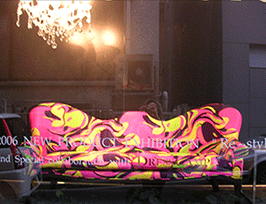
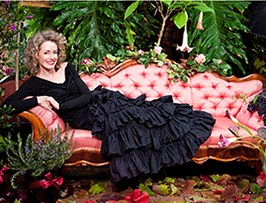
Seeing this couch in the Hanae Mori window later inspired this 'Gothic Garden' of black edibles.
As I was leaving, I saw a handbag in the display window. It was vault-shaped and black like a doctors bag, but had the glamor of the travel-cases you'd find on the gloved arm of a 1960's Air hostess. I was about to get on a plane, returning to Australia the next day. My old handbag was full of Japanese yen from the workshops I had been teaching, and I thought "Maybe its time to stay thank-you to myself with something really nice'.
The bag was made of a strong, self-patterned fabric. Its corners and zipper frames were reinforced with glace leather, as were the carefully beveled handles, that fit snugly in my hand. The leather gleamed softly, and had that expensive leather smell, warm and natural.
There were no meaningless buckles or shiny decorations, every feature on this bag served a purpose, to support, to strengthen. Thats the kind of woman I'd like to be, useful and beautiful. Maybe thats why I said "I'll have this'
There was a matching purse in pink, so I took that too. When you find something good, get it and its whole family.

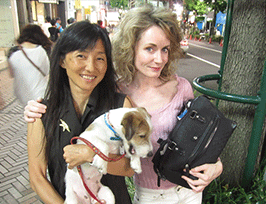
All my luggage for a 10 day Permaculture lecture tour, at Hammatsu University of Culture, Permaculture farmhouse, the Mori-no-ie in Gifu.
Outside the Shibuya AppleStore, by chance I met my friend Riko. She produces the Permaculture calendar, using my illustrations. Neither of us are married yet, so instead of children she has a dog, and I have a nice handbag!
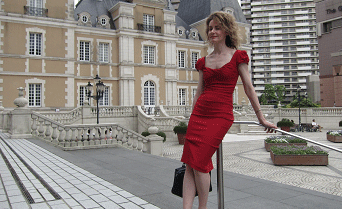

The bag is black, but I am happy to use it summer and winter, as it looks good with everything I wear, and matches my black parasol
How my bag cares for me
Some years, I live out of a suitcase for six months. Yet I must make a good impression on the people I meet, or they will not want to become my customers or colleagues.
Having an expensive handbag in pristine condition is a clue about my character. 'Here is a lady with enough competence and discipline to buy and care for good things". They don't know about the time I put my drink bottle in without tightening the lid...But 'competent' and 'mindful' is something I put work into becoming, every day, and my handbag is a taslisman of these desireable qualities.
Australian Values: "No Worries, mate!"
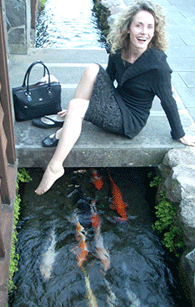
The design of my Hanae Mori bag makes it spacious inside, and filling it up does not distort its well-made shape. The way I fill it would ruin a cheaper bag. I often carry a whole day's equipment, even a change of clothes or my lunch.
It has four metal feet underneath, so I can put it on the ground without it getting worn or dirty. In Japan however, putting handbags on the ground is considered disrespectful, so I try my best to follow Japanese etiquette.
Once I was standing on the bus, very tired. I put my handbag on the floor, and closed my eyes. I was suddenly awoken by a kind old lady taping me on the shoulder. 'Excuse me, you dropped your bag' she said, as she handed it back.
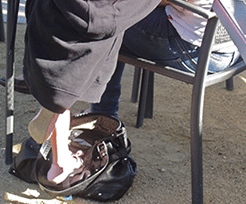
A surprising sight at a restaurant here in Sydney.
Japanese people seem to have an awareness of their things that us Aussies do not possess. One day at a rather nice outdoor restaurant I was surprised to see a lady put her handbag in the dust. The surprise skyrocketed a few minutes later, as her 8 year old daughter decided to use it as a step to talk to her mother, dancing up and down on it as she went.
I guess she takes after her mother, and doesn't really care about her things. Or maybe Im just not used to the Aussie Culture of 'no worries'.
Maybe when this little girl grows up she will go to Japan and fall in love with the nice things here, and the way that people care for them.
Thats what happened to me.
How my handbag cares for me.
The things I learned in Japan are the reason why I'm able to have my dream job, teaching people how to truly care for their world, starting off by taking good care of their own selves.

April 24, 2013
Vol.13 As tough as leather
Allan Murphy
Hello, I am Allan. I come from Vancouver, Canada. It is very beautiful there and is the sister city of Yokohama. Tokyo's winters are milder, but Vancouver's summers are much more pleasant: 25C with low humidity.I am an English teacher and writer. I first came to Japan about 30 years ago as part of a tour of Asia - I visited Hong Kong, Thailand, Malaysia, Indonesia, Nepal. India and then came to Tokyo. I certainly had no plans to stay because there were so many opposites: Japan was crowded, conformist and not very friendly to vegetarians. But, Japan has a long history and a deep culture. As one of my friends said (I wish I had): "Scratch the steel and find bamboo." It is the "wabisabi" aspect of Japan that has kept me here - as well as my wife and two lovely daughters. They fit me like a glove.
 I first realized the special quality of leather when I was about 16. I spent the summer working as a carpenter on an island between Vancouver and Victoria. My uncle gave me an old pair of leather gloves. They were well worn in. They were strong and soft - and this is what impresses me about leather: strength and flexibility. I hammered nails, sawed wood, poured concrete and my hands were well protected - except for the time when I hit my thumb instead of a nail. There are some things even a pair of strong leathers gloves can't do.
I first realized the special quality of leather when I was about 16. I spent the summer working as a carpenter on an island between Vancouver and Victoria. My uncle gave me an old pair of leather gloves. They were well worn in. They were strong and soft - and this is what impresses me about leather: strength and flexibility. I hammered nails, sawed wood, poured concrete and my hands were well protected - except for the time when I hit my thumb instead of a nail. There are some things even a pair of strong leathers gloves can't do.My carpentry experiences taught me about leather's qualities. Then, a couple of years later in my university archaeology classes, I learned the importance of leather in ancient societies: for clothing, footwear, shelter, belts and even boats and containers of liquids. The durability of leather has improved human lives considerably. Buckskins.
Consequently, the English language has idioms relating to leather's properties.
Expressions like "as tough as leather" or "as tough as old boots" or "as tough as shoe leather" are common. When referring to an inanimate object the meaning is almost always positive. Such as an old car that is as tough as leather: it still runs well although it is 30 years old. However, when referring to people it can have both positive and negative meanings. For a worker or a football player to be described as being as tough as old boots is a very good meaning.
On the other hand, a person who is a very difficult negotiator or someone who is quite stubborn could be as tough as old boots. They would be difficult to deal with.
But leather is blessed with another quality: pliability. Kid gloves (gloves made of young goat or lambskin) became fashionable in Britain in the 1830s. They were soft and elegant gloves for gentlemen.
So, when a topic arose that required delicacy: a divorce, money that was owed and a variety of other social issues it said that the matter must be treated with kid gloves. In addition, when it comes to diplomacy, territorial issues and so on must be treated with kid gloves.
I don't have my carpenter's gloves any longer. Twenty years ago, my wife and I visited Vancouver to spend Christmas with my parents. It was cold that winter and it snowed. My father gave me a pair of fleece-lined gloves because I hadn't brought any with me. My father passed away some years ago but the gloves remain. The gloves are warm, soft and strong - just like my Dad.
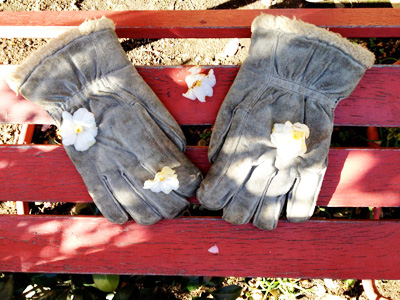

February 1, 2013
Vol.12 In France, taking off shoes is the same as taking off clothes
Daniel Hadida
Hello, my name is Daniel, I'm French, and I'm the director of a French language school in Hamamatsucho. I've been living and working in Japan since March 2012 and am totally enjoying the city of Tokyo.

Speaking of France, we have famous Fashion brands such as LOUIS VUITTON and Hermès. However, we usually don't purchase those brand items. I see more often that Japanese girls carry those brand items. To be honest, I found it very strange that even high school girls own fashion brand bags.
In general, the French is said to be stylish. We don't try to be stylish, but we naturally care about the fashion coordination of bags, shoes and hats. Especially when ladies buy new shoes, they definitely scream out that "We have to buy bags that go along with shoes!" That is how we grow up and it is now a part of our life, I suppose.
In France, we don't have school uniforms. Parents buy clothes for children and they choose what to wear to school. Not only clothes, but school bags are normally chosen by children. Parents only check its quality. Although lately you see more kids using suitcases with wheels to carry heavy textbooks.
For the French, it is more important to choose what suits your life style rather than fashion brands. Therefore, we focus more on what material they use rather than expensive or fashion brand items. For example, it is said LOUIS VUITTON use strong weather material and that is why their suitcases are famous and popular. Small bags do not require that level of quality.
I have to say that we care more for shoes than Japanese people. We do not take off our shoes at home, so that means that Taking off shoes is the same as taking off clothes for us. That is why we naturally coordinate the shoes as a part of important fashion. For my shoes, I usually want cordoban (horse leather), because it's highly resistant to weather, lasts 10 to 15 years and, more importantly, it doesn't need weekly maintenance. For belts, watch straps or wallets, calf leather is fine enough, but cordoban belts or crocodile watch straps can be good-looking too !
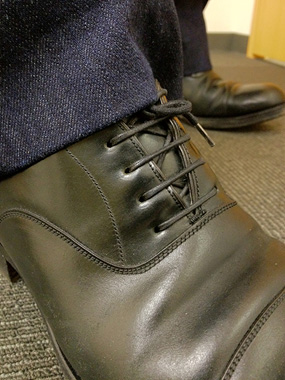
Another difference between Japan and France regarding leather goods, I would say that the most striking difference is bags. In Europe, men usually don't have "hand bags" like women, so it's a bit surprising to see Japanese men carrying some the first time you set foot in a Japanese big city. On the other hand, Japanese men are much more fashion-conscious than European ones, so it doesn't look weird on them.
Japanese bags seem rather simple compared to the bags in Europe, which have zippers, pockets and strap. Maybe that doesn't look too weird for men to have "hand bags" I suppose.
Manufacture-wise, it stands up to the standard of manufacturing you've come to expect from Japan: top notch. I actually know of a Japanese manufacturer who went to England to learn the ropes of bag sewing, leatherwork and saddler. Fashion brand are always good, but looking back what you always have, high quality Japanese leather products would be worthwhile.

November 26, 2012
Vol.11 In Praise of Pen Cases
Alice Gordenker
 The first time I fell in love with something made from leather was when I was 21 years old and studying at a university in Tokyo. The year must have been 1981 or 1982. I was in a department store in Shinjuku when I happened to pass the stationary goods section . I wasn't planning to buy anything there. I was just passing by. But something caught my eye.
The first time I fell in love with something made from leather was when I was 21 years old and studying at a university in Tokyo. The year must have been 1981 or 1982. I was in a department store in Shinjuku when I happened to pass the stationary goods section . I wasn't planning to buy anything there. I was just passing by. But something caught my eye.
It was a small leather case, maybe 15 centimeters long and five centimeters wide. It was black with a dragonfly pattern in a pretty cream color. I stopped and picked up the case. I was surprised how light and soft it was in my hand. I turned it over, appreciating its butter-like feel . It had a zipper on the side and I realized it was a case for pens.
The price seemed very expensive to me. I was a student , living on a tight budget and I never bought anything unless I absolutely needed it. I definitely didn't need something to put my pens in, but I bought that pen case anyway.
I grew up in the United States, where there is no custom of keeping your pens in a case. In school we used pencils that we all shared, and at the end of the day we put them in a jar on the teacher's desk. We didn't have pencil cases and we didn't carry our pencils back and forth between home and school.
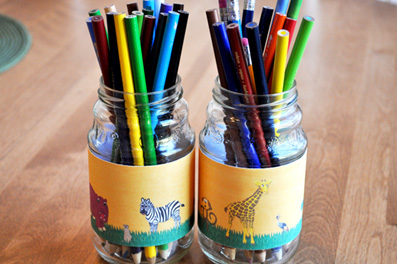
But I quickly developed a habit of keeping my pens in that pen case. I used it all during my studies in Japan, and every day when I took it up in my hand I enjoyed its luxurious feel . I began to notice that the Japanese students around me all carried pen cases too.
After two years of study I went back to the United States. At first I carried my Japanese pen case to my job in New York, but my co-workers mostly used cheap pens that floated from desk to desk. After a while I left the pen case at home. We moved several times and somewhere along the way the pen case was lost.
In 2000, I moved back to Japan. This time I had children and I put them in Japanese school, where I was surprised that every child was required to have a pencil case. My children were taught to organize their pencil cases every evening, making sure they had three regular pencils and one red pencil, sharpened and ready to use the next day. I could see that learning to care for one's tools is an important part of Japanese education, and that the habit carries on into adulthood. Business meetings never seem to begin until everyone has arranged their business-card case, glasses case and pen case on the table.
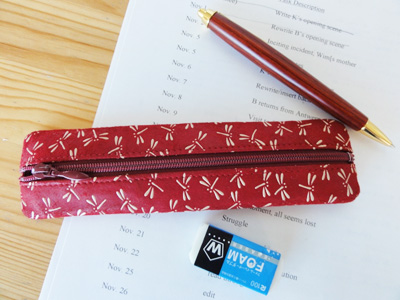
One day in a store I spotted a pen case very similar to the one I had bought long ago. It even had the same dragonfly pattern. The clerk explained that it was a traditional craft item called inden , made by applying designs in lacquer on deer leather. She explained that the old word for dragonflies was katsumushi (victorious insects), so hoping to win in battle, samurai often decorated their armor with dragonflies.
Strictly speaking, I didn't need a pen case. I do most of my writing on a computer, and when I do carry a pen, one is enough. It doesn't have to be in a case. But I bought that pen case anyway. And every time I pick it up, I feel how smooth and buttery it is and I appreciate the Japanese values of having beautiful things and taking good care of them .

September 21, 2012
Vol.10 Japanese leather products in the eyes of an English gentleman
Robert Pott
 My name is Robert Pott, and I was born 35 years ago in the UK. Thanks to my father's job in the navy and foreign postings, I was educated in a traditional British boarding school. Leather for me meant shiny cricket balls(twisted a string and leather around the cork) and having to polish my shoes the old-fashioned way a few times a week.
My name is Robert Pott, and I was born 35 years ago in the UK. Thanks to my father's job in the navy and foreign postings, I was educated in a traditional British boarding school. Leather for me meant shiny cricket balls(twisted a string and leather around the cork) and having to polish my shoes the old-fashioned way a few times a week.
English gentlemen are known for taking proper care of their possessions, their respect for quality, interest in how things are made, and for being a decent member of the community. For us, the ideal possession is handcrafted with care and skill and can be passed down to our children. These ideals are perhaps best exemplified by the royal warrants awarded by the Queen to companies handcrafting products of excellence and quality.
The royal household's leather products such as horse-riding whips and gloves are made by Swaine Adeney Brigg. Leather is favoured by gentlemen due to its durability and responsiveness to proper care. For this article I set out to find excellent examples of handcrafted leather goods around me in Japan, judged by the standards of an English gentleman.
I live with my family in a cabin in the forest in Isumi City, Chiba Prefecture, and I teach English in high schools nearby. I use the Porter bag you can see in my profile picture every day at school. It used to belong to my wife's father. The design and quality are fabulous, and it is sturdy enough that I can imagine passing it down to my child one day.
English gentlemen like to meet the people whose skill crafts their possessions, so I always enjoy the annual "Earth Day Tokyo" festival in Yoyogi Park, where there's always a good number of artisans exhibiting and selling their handicrafts. At this year's event, I found two leather-craft stalls.
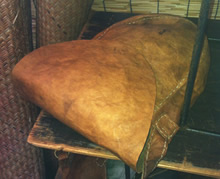 Otake-san from chahat creates sturdy bags and wallets with rugged, natural designs, sourcing his leather from Nepal. On his iPad he showed me pictures of the traditional tanning process. The hides are tanned using vegetal tannins, and treated with a mustard oil mixture for suppleness. Villagers knead in this mixture with their feet while holding onto ropes hanging from rafters to keep their balance.
Otake-san from chahat creates sturdy bags and wallets with rugged, natural designs, sourcing his leather from Nepal. On his iPad he showed me pictures of the traditional tanning process. The hides are tanned using vegetal tannins, and treated with a mustard oil mixture for suppleness. Villagers knead in this mixture with their feet while holding onto ropes hanging from rafters to keep their balance.
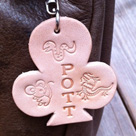 A few weeks later, I visited Herb Island close to my house. There I came across a leather stall called ST!TCH run by hobbyist craftsman Tateno-san. He sells leather tags which customers get to stamp with various designs. I spent a delightful 15 minutes stamping the Chinese zodiac animals of the 3 members of my family around our surname.
A few weeks later, I visited Herb Island close to my house. There I came across a leather stall called ST!TCH run by hobbyist craftsman Tateno-san. He sells leather tags which customers get to stamp with various designs. I spent a delightful 15 minutes stamping the Chinese zodiac animals of the 3 members of my family around our surname.
Porter's design quality, chahat's sourcing of traditional eco-leather, kazoo's use of an interesting and high-quality material, and ST!TCH's focus on customization; these 4 leather brands each have qualities an English gentleman can admire.
However, the decent community-member in me was most drawn to chahat's products. That's because I think his business model does the most to nurture a sustainable, healthy community. Happily, this awareness is growing. Back at Earth Day Sakurai-san told me Japanese tanning companies recently agreed to switch to eco-leather. Searching online reveals a set of Japanese eco-leather standards in place and even an eco-leather company offering tours of its factory!
With Japanese artisans continuing to hone their skills, innovatively customize their products, and become more eco-friendly, English gentlemen in Japan have a lot to look forward to!

July 11, 2012
Vol.9 Awareness for leather product
Niramon
Hello. My name is Niramon. I have been interesting in Japanese language and culture form olden years, so I entered the university in major of Japanese language. Current I work as a thai-japanese interpreter in Japanese company in Thailand. I am really honored to write column in this time.
When speaking of「Leather product」, I can raise only bag or shoes which made by cows or crocodile’s leather with elegant design. I deeply impressed that leather product are [The middle-age’s fashion] because they are adult-liked simple design and black or brown tone which loved by the middle-aged.
Certainly there is also having world-famous brand in Thailand but they were imported so they take high price. However the people who adored in leather are not less. People who want take Thai brand leather even without the world-famous brand are a lot.
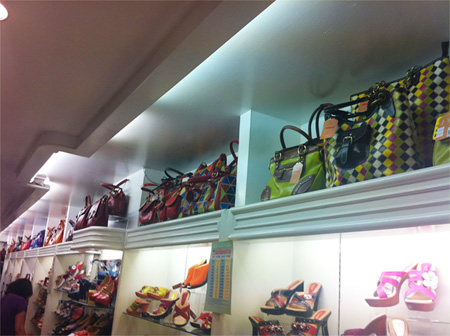
My mother is also one of them. Anywhere when she saw shops of [Leather], she will go straight on to the shop. When get into the shop you can see people selecting bags, and they are same age as mother. That makes the impression of「The middle-age’s fashion」more stronger.
By the way, Thai leather is cheap and had good quality that recognized in many countries too. They are a lot of Thai-branded leather product which export to America or Denmark. And the prices are not too expensive. Such as handbags take about 2000-70000 baht(100Yen=about 38Baht). Even though they are relatively affordable, they are not popular to young people. Because young people think designs and color tone that hardly coordinate with clothes, the bags which take on made form plastic or cloth product are well-selling than leather.
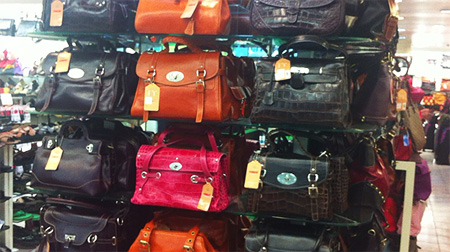
My first trip to Japan was 3 year ago .Every time I come to Japan since then, shopping in Japan is my enjoyment. I often stroll in the town and when I found an interested shop, I get into. And I met preferred item many times.
One day I was strolling in Yokohama and I found a fascinating shop. The shop named [genten], the brand which promotes about the environment and rise up the ECO consciousness. First time I just thought that a beautiful shop and maybe met some good things, so I got into the shop. In the shop, they are types of bags, almost of them look simple and possible to matching to any styles, so I got falling love them. When the shop staff introduced that they are made from leather, I remember that I was quite surprised. Because, these bags is completely different to the leather I knew. The price was high but however I took on my purchase power and decided to challenge.
Then I came back to the hotel and take a close look to the bag. Its quality was better than compound leather and feeling is also different. After I back to Thailand, my friends praised about the bag. That made me so proud and favorite using it. Now it took about 2 years, and I first time found fascination of leather. If they are Plastic or linen, when they take long time then get old we have to throw them away. But leather was different. When it has been used for a long time, it would be softer and color would little change. That makes me feel like it growing together with us.
And now I understood that why people whom chosen the leather a once they will wish for them all the times. And a person who always ignored “leather”like me, also became a person who always ask the shop that "This is leather?"

May 25, 2012
Vol.8 The appeals of the leather bags made in Japan
WonYang
I came to Japan from China as an oversea student in 2005. Now I'm working at a computer-related company.

Labor Park in Dalian, China
I'm a fan of the leather bags made in Japan. When I go shopping, I go to the bag corner every time. The first made-in-Japan leather product that I bought is a bag, too. It's a reward for me when I got hired four years ago.
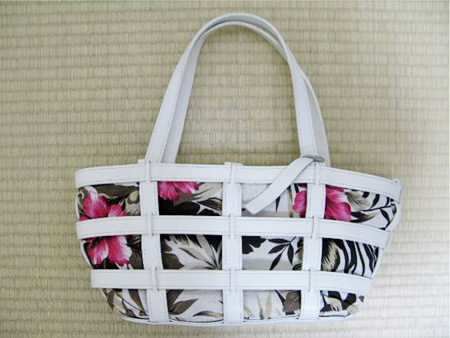
At that time, even though the light nylon bags were very popular, I chose the leather one,because the leather bag feels very good and it looks much more exclusive. In addition, the leather bag is more durable, you can use it for a long time if you take care of it. Most importantly, the more you use it, the more beautiful the color of it will be. It is really a pleasure to enjoy this amazing process.
When I was in China, I also bought many leather bags which are made in China. Therefore, I know the differences between the Chinese bags and the Japanese bags well. For example, the perfection of the finishing, the delicateness of the color and so on, beyond which, I would also like to point out two most important differences.
Firstly,the pursuit of natural leather. The bags made in Japan usually keep the scratches, creases and the change in depth of the color of the leather, to maintain the proof of natural. However, in China, these seemingly "demerits" are usually covered by surface processing in order to show the perfectness of the leather. In my opinion, the scratches, creases and the change in depth of the color are just the unique features that the leather naturally holds. In a sense, they are also the appeals of the leather, therefore the coverage of them will, contrarily, lead to the reduction in the charm of the leather, which will be very regretful for the fans of the leather bags.
Secondly,the balance of the practicality and fashion of the bags. The leather bags made in Japan are not only practical, but also very fashionable, through pursuing the softness and color of the leather used. But in China, the leather bags are usually considered as that they are more often used by mature women and they go better with formal suits. In other words, the leather bags made in China are practical but not fashionable enough.
Although the leather bags made in China are cheaper than the ones made in Japan, however, in recent years, with the development of economy, the price in China is much higher than before. Therefore the difference in price also become much smaller between the leather bags made in Japan and China. Considering the circumstances, the leather bags made in Japan are more durable and fashionable, so they are still the first choice for the fans of the leather bags like me and it keeps giving great appeal for us.

March 26, 2012
Vol.7 From the smell of leather―To those nostalgic days
Jeffrey Jousan
Hello. My name is Jeffrey. I come from New Jersey State and when I came to Japan, I first worked at a foreign language school, but now, while running an IT company, I’m taking part in musical activities in Ibaraki. I am living very happy days.
As I am having my article published on a leather homepage, I tried to cite things that came into my mind about leather.
‘My favorite suede jacket’, ‘James Dean, ‘leather jackets’, ‘baseball gloves’, etc. Now, as for that last one, ‘baseball gloves’, when I played catch ball with my child the other day, I smelt the smell of this glove and remembered many things from when I was a child. Then, I felt very nostalgic.
When I was a child, I was truly surrounded by a lot of leather. Because my parents were from Texas, when I went to my grandparent’s home, there was the saddle and bit used for horse riding, and cowboy boots plus a leather hat. In my parent’s home too there were normally leather jackets, work boots, a cigar case, mounted animals and I also recalled that above all, I loved leather gloves.
The memory of your childhood is a mysterious thing, so even now the soft feeling of leather, or if I smell the exquisite smell of leather, the cool appearance of cowboys I saw in my childhood, and the fun memories of horse riding come one after another, and when it comes to leather, only good memories come to mind.
I came to Japan and of course I like and am using leather products like bags and shoes, however, I realized there isn’t much leather in the immediate surroundings of my life. America, and especially my home state of New Jersey, is a place that has a culture of using leather a lot from a long time ago, including in clothing. When I was a child, many leather products were sold in the neighborhood shop, and just like normal cloth and plastic, it was used in many things like clothes, accessories and stationery. All the adults naturally used leather products, and they were always in a place within reach. When you touched them they were soft, (there were some hard ones too) and they smelt of leather.
In Ibaraki now, when it comes to shopping, people go to Ito-Yokado. There, I mindfully looked at the leather products but apart from school bags, there were hardly any other leather products sold that children use. In addition, for things that adults use too, there are hardly any products apart from shoes and bags. Wallets and belts were being sold, but the smell is different and synthetic leather is not real leather. When comparing America and Japan, the price of leather products is very expensive in Japan, so I guess everyone can’t buy them easily. Especially for children, I had a feeling that when it comes to leather, there are only school bags and baseball gloves. When I investigated on another occasion, the school bag in our house wasn’t real leather. As for my child, they probably don’t know the smell of leather.
I wonder with what smell the children of nowadays will remember their olden days. Upon writing this article, I realized anew that by smelling leather, I recall my childhood. Today, I will put my leather gloves by my side from now on, and I think I will write a song while remembering those fantastic days. Thank you very much for reading.

How Japanese Leather products are perceived by foreigners living in
Japan and Japanese overseas?
“Mekakushi” from outside may shed a light on and help you open the eyes
to the undiscovered.
- Vol.16 Japanese Leather - Full of Surprises!
- Vol.15 Leather goods of South Africa have taken root in my life
- Vol.14 Traveling life lightly: A Permaculture Designer's experience with Japanese leather
- Vol.13 As tough as leather
- Vol.12 In France, taking off shoes is the same as taking off clothes
- Vol.11 In Praise of Pen Cases
- Vol.10 Japanese leather products in the eyes of an English gentleman
- Vol.9 Awareness for leather product
- Vol.8 The appeals of the leather bags made in Japan
- Vol.7 From the smell of leather―To those nostalgic days
- vol.6 Mainland shoppers towards Leather Products
- Vol.5 Readily Available or a luxury- the leather culture difference between Korea and Japan.
- vol.4 Japan Leather Award 2011
- Vol.3 Professional Pride in Monozukuri
- Vol.2 My first encounter with Japanese leather
- Vol.1 Hidden Treasure



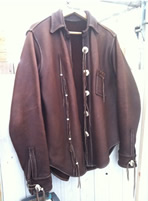 Meanwhile, Sakurai-san of kazoo had a jacket and some purses for sale. The leather was of a much darker hue than chahat's, much suppler, and had a more finished look. His leather was New Zealand deerskin chrome-tanned in Japan.
Meanwhile, Sakurai-san of kazoo had a jacket and some purses for sale. The leather was of a much darker hue than chahat's, much suppler, and had a more finished look. His leather was New Zealand deerskin chrome-tanned in Japan.






